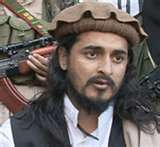 If you look closely at the picture above, you'll see GEN McChrystal laying out a (very rough) enemy SITEMP - highlighting the centers of gravity and areas of operation for the main enemy groups: QST (Quetta Shura Taliban), HQN (Haqqani Network), and HIG (Hizb-e-Islami Gulbuddin). For more on his assessment of the groups' capabilities/intentions, read pg. 2-5 through 2-8 of his COMISAF Assessment.
If you look closely at the picture above, you'll see GEN McChrystal laying out a (very rough) enemy SITEMP - highlighting the centers of gravity and areas of operation for the main enemy groups: QST (Quetta Shura Taliban), HQN (Haqqani Network), and HIG (Hizb-e-Islami Gulbuddin). For more on his assessment of the groups' capabilities/intentions, read pg. 2-5 through 2-8 of his COMISAF Assessment.Before digging deeper into the enemy situation at the province/district level (which I discussed in a post yesterday) and in violation of my statement against PowerPoint, I wanted to share this excellent graphic from the Institute for the Study of War. While pretty basic, it provides an overview of the main enemy groups, their key leaders, and rough areas of operation. As you can see, it pretty closely parallels GEN McChrystal's whiteboard sketch. You'll also notice that the ISW graphic includes groups operating from Pakistan that influence the security situation in Afghanistan (particularly AQ, TTP, and LeT). Download it in PDF format here.
 When you overlay this map with the one I posted yesterday (courtesy of the LWJ), you get a good feel for the overall enemy areas of influence - the Taliban strongest around Kandahar and Helmand in the South and extending into Quetta in Pakistan (where their C2 and LOG nodes are based); the Haqqani Network dominating the terrain and populace in Khowst, Paktia, and Paktika (P2K); and HIG dominant in Nangarhar, Nuristan, Kunar, and Laghman (N2KL) with support lines into Pakistan. Of course, we all know it's never this simple; all of the groups have some presence throughout the country and often cooperate to a certain degree (especially at the local level). As McChrystal explains in his assessment, "these groups coordinate activities loosely, often achieving significant unity of purpose and even some unity of effort, but they do not share a formal command-and-control structure. They also do not have a single overarching strategy or campaign plan."
When you overlay this map with the one I posted yesterday (courtesy of the LWJ), you get a good feel for the overall enemy areas of influence - the Taliban strongest around Kandahar and Helmand in the South and extending into Quetta in Pakistan (where their C2 and LOG nodes are based); the Haqqani Network dominating the terrain and populace in Khowst, Paktia, and Paktika (P2K); and HIG dominant in Nangarhar, Nuristan, Kunar, and Laghman (N2KL) with support lines into Pakistan. Of course, we all know it's never this simple; all of the groups have some presence throughout the country and often cooperate to a certain degree (especially at the local level). As McChrystal explains in his assessment, "these groups coordinate activities loosely, often achieving significant unity of purpose and even some unity of effort, but they do not share a formal command-and-control structure. They also do not have a single overarching strategy or campaign plan."With this big-picture understanding of the enemy situation in mind, we can now devote some additional effort to understanding things at a more localized, granular level. In my next post on this topic, I'll provide an overview of the enemy situation and operational environment in Helmand Province (home to several Taliban strongholds along the Helmand River valley including Musa Qala, Nawa, Marja, Baramcha, Gereshk, Sangin, and Garmsir). As the NY Times discusses in a great article today (read it here), this is the province where the largest concentration of ISAF forces will be focused - currently there are nearly 10,000 Marines (of the II MEB) here and the first troops sent as part of the "Afghan surge" will head here sometime later this month. Once these additional Marines assume battlespace, there will be nearly 20,000 US and British troops conducting COIN ops in the province. It's clear to me that McChrystal has prioritized Helmand (and likely Kandahar province to the east) as the areas where additional US forces can potentially have the greatest impact, making it critical for us to really understand the situation on the ground there and the challenges ahead.




.jpg)






Initial reports from the AP indicate the Marines currently stationed in Helmand kicked off a large op (Operation Cobra's Anger) today in the Nowzad Valley in N. Helmand. 3-4 Marines and Marine Recon were involved in the combined air assault (via MV-22 Osprey) and GAC assault from the Marine outpost in Nowzad. For more details, see the full article here: http://news.yahoo.com/s/ap/20091204/ap_on_re_as/as_afghanistan
ReplyDelete